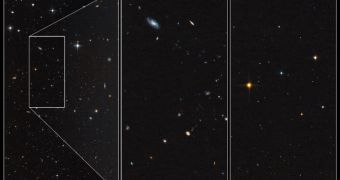Our galactic neighborhood is filled with a large number of extremely faint dwarf galaxies, which orbit the Milky Way at a close distance. These formations contain very few stars, and astronomers believe that using the Hubble Space Telescope finally enabled them to explain what is happening.
The reasons why these dwarf galaxies have so few stars have been of great interest for investigators, but efforts aimed at clearing this mystery have thus far failed. Scientists say that these objects are, most likely, the smallest and most pristine galaxies in the Universe.
Since they are very dim – on account of their lack of stars – these objects cannot be readily identified by telescopes. Scientists found most of them while browsing through a 10-year database produced by the Sloan Digital Sky Survey.
In a recent study, the Hubble was used to image three of the dwarf galaxies orbiting the Milky Way. Astronomers were surprised to learn that most of the stars in these galaxies were roughly the same age.
Additional investigations revealed that the galaxies began forming soon after the Big Bang, and also that the process stopped abruptly. In all, the structures formed stars for just 1 billion years or so. The Universe is currently estimated to be 13.75 billion years old.
What the conclusions of the new study suggest is that the Cosmos passed through a transitional phase around 12.75 billion years ago, which stopped star formation in small galaxies, while somehow allowing the larger galaxies to go about their usual business.
Interestingly, the period of time when dwarf galaxy stellar formation processes were active coincides with the reionization epoch. The latter is a span of time following the Big Bang when the entire Cosmos was filled with cold hydrogen, which was burnt by the first stars.
“These galaxies are all ancient and they're all the same age, so you know something came down like a guillotine and turned off the star formation at the same time in these galaxies. The most likely explanation is reionization,” says expert Tom Brown.
He holds an appointment as a researcher at the Space Telescope Science Institute (STScI), in Baltimore, Maryland, and was also the leader of the new investigation. The scientist explains that reionization was carried out by the first stars.
These objects released vast amounts of radiation, which removed electrons from hydrogen atoms, making the H2 gas transparent to ultraviolet light. Astronomers now believe that these radiations are responsible for shutting down stellar formation in dwarf galaxies as well.

 14 DAY TRIAL //
14 DAY TRIAL //